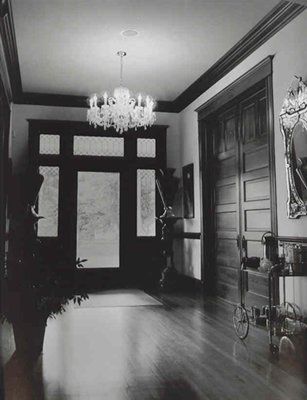ISAAC HARRIS HOUSE
BIOGRAPHY OF ISAAC HARRIS
Isaac Harris was a man whose interest in Mooresville ran very deep. He was one of the original members named in the Charter to Incorporate the Village of Mooresville.
It is believed that Isaac Harris built the Colonial Revival home at 330 South Main Street in the early 1900’s, just prior to his death. Isaac Harris served on the first Town Board which was set up in 1873. In May of 1874, became the first duly elected Mayor of Mooresville. He was elected nine different terms as Mayor and served as a commissioner many terms. The last time he was elected, he refused to run but his name was put in the hat anyway. He turned down the job. When the town would run low on funds Isaac Harris would loan the town money to operate on, refusing to accept any interest on repayment.
When plans were underway to have a connecting line from Mooresville to Barber's Junction to give rail service to Winston-Salem from Iredell County, a meeting was called for those interested to meet at Mocksville. The business people of Statesville wanted this line as did those of Mooresville. At this meeting it was announced by the railroad officials they were ready to proceed.
The railroad officials informed those present that whoever was ready to put up a cash deposit would get the branch line.
This deposit was in the amount of several thousand dollars (said to be $6,000). The people from Statesville were not prepared as they did not have that kind of cash with them. Isaac Harris announced he had the cash and put up the money that day. This is the reason Mooresville received railroad service to Winston-Salem.
Before Mooresville's first bank opened in 1900, Isaac Harris acted as a depository for many of his friends. He had a big safe in his home and many residents would ask him to keep their cash, which he did, giving them a receipt for the amount left.
The Mayor also acted as Judge. During one of Isaac Harris' terms as Mayor, in 1876, an ordinance was passed against tying cans or other objects to a dog's or cat's tail. A Mr. Dobey decided he would test the ordinance and see what would happen. He put some rocks in a tin can and tied it around a dog's torso, turning the dog loose in the presence of Mayor Harris. Mayor Harris cited Mr. Dobey to the Mayor's Court, and at the appointed time he asked Mr. Dobey, "How do you plead, guilty or not guilty?" "Not guilty," replied Mr. Dobey, explaining he had not tied the object to the dog's tail but around the dog's body and that this was not covered by the ordinance. The Mayor promptly handed down a guilty verdict advising Mr. Dobey he "could not invade the law in such a manner". The record does not show what fine was levied.
Isaac Harris was also interested in many businesses in Mooresville and was one of the founders of Harris, Sherrill & Co., which later was known as Mayhew, McNeely Co.
Isaac Harris was the grandfather of Lutelle Sherrill Williams of Winston-Salem, North Carolina. Mrs. Williams was raised in a house that was on the site of the Mooresville Public Library, next door to the Isaac Harris House.
Mrs. Williams married S. Clay Williams who was president of R.J. Reynolds Tobacco Company. In 1939, Mrs. Williams built the Mooresville Public Library on the site of her homeplace and she donated the library to the Town of Mooresville.
(This story of Isaac Harris was adapted from the informative book, Mooresville, The Early Years, by W. J. Hazelton.)
THE ISAAC HARRIS HOUSE HISTORY
The Isaac Harris House is now home to the law offices of Homesley & Wingo Law Group PLLC. It seems fitting that the home of a man who had such a profound influence on the rule of law in Mooresville's formative years would now house a law practice.
It is believed that Isaac Harris built the Colonial Revival home at 330 South Main Street sometime in the early 1900's. At his death in 1906, Isaac Harris willed the house to his son, Jimmy Lee Harris. Jimmy Lee Harris and his wife, Annie M. Harris lived in the house until their deaths in the 1950's.
Unfortunately, around 1935, the property was foreclosed upon but Lutelle Sherrill Williams was able to purchase the property at foreclosure. This allowed Jimmy Lee and Annie to continue to live at the property. In the 1940's and 1950's, the Harrises rented rooms on the second floor to boarders. Some local people recall living in the house at that time.
The Isaac Harris house adjoined the Dr. G.W. Taylor home. In the 1930's, Dr. Taylor built a new home across from the hospital and donated his old Main Street home for use by the Mill as a "Community House." Older folks have many fond memories of this house and the ballfields and tennis courts which surround it.
In 1955, Mrs. Williams conveyed the Isaac Harris House and surrounding land to the Mooresville Woman's Club. Interestingly, the deed contained certain restrictive covenants as follows:
1. No noxious or offensive trade shall be carried on upon any part of this lot.
2. The keeping of cows and horses on this lot is prohibited.
3. No public garage, trailer camp, service station, super market, or grocery store shall be permitted on these premises.
Bill and Hazel Sprinkle bought the property from the Woman's Club in 1957. Before closing, a document was recorded which clarified the restrictions to allow a "AAA-approved" motel to be built on the subject property. The Sprinkles proceeded to build, own and operate what is now known as the Relax Inn.
Bill Sprinkle was well-known for his vast collection of railroad memorabilia and model trains. Mr. and Mrs. Sprinkle passed away by the early 1980's and the Isaac Harris House was inherited by their nephews from Virginia.
Von Patel bought the Isaac Harris House and the adjoining motel in 1986. Mr. Patel ran a lamp making business in the Isaac Harris House which was converted into a lamp assembly building. This business had been dormant for the last few years before purchase of the Isaac Harris House by Clifton W. Homesley on June 30, 1997.
The house had been victimized by neglect and vandals and was in dire condition as of 1997. It took several months to shore up the building and to remove the vast amount of lamp-making materials and equipment from the building. Clifton W. Homesley led the renovation project. Construction began in earnest in late October, 1997 and was completed on June 23, 1998.
THE ISAAC HARRIS HOUSE TODAY
Homesley & Wingo views the house as an asset of the entire community. The firm is open to the ideas of anyone as to ways the house can be used to make our community a better place in which to live.
The law office is home to a vibrant collection of original artwork, including the following: Apsaras done from rubbings of the Angkor Wat temple by native artisans in Siem Reep, Cambodia; glasswork purchased in New York City; multimedia works by Susan Godfrey; acrylics by Jennifer Kinion; oil paintings by Babak Emanuel and Michael Goddard and oil paintings by Sahar Fakhoury of Asheville.
Homesley & Wingo Law Group, PLLC
This website has been built to be accessible for all users. If you experience any difficulty in accessing this website, please contact us for assistance.
The information on this website is for general information purposes only. Nothing on this site should be taken as legal advice for any individual case or situation. This information is not intended to create, and receipt or viewing does not constitute, an attorney-client relationship.


